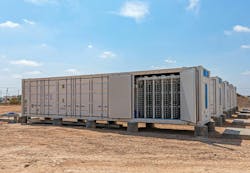Navigating battery energy storage augmentation
As renewable energy sources continue to dramatically influence the electric grid, energy storage is playing a pivotal role in achieving grid resiliency. Though there are many available energy storage technologies, lithium-ion batteries are the most common energy storage technology. These battery energy storage systems (BESS) supply reliable power to the grid during times when renewable energy sources cannot, such as when the wind is not blowing or sun is not shining, and provide many auxiliary benefits.
One key design consideration for batteries is that they degrade over time. This means the amount of energy a battery can store is at its maximum on the first day of deployment and will steadily diminish until its end of life. To maintain facility capacity, more energy storage needs to be installed through a process called augmentation. Augmentation may also increase the site’s capacity and gives facility owners and operators enhanced functionality. Whether installing a new facility or expanding existing systems, the augmentation process requires careful upfront planning.
Before breaking ground on any battery energy storage system (BESS) project, preparing for future augmentation efforts is essential. Augmentation planning should consider permitting; potential impacts to civil, structural, electrical, supervisory, control and data acquisition; fire protection designs; and constructability. By implementing an augmentation plan upfront, owners can minimize potential delays and unforeseen costs when augmentation needs to occur.
A critical component of augmentation planning is the planned integration of future equipment with the initially installed equipment and infrastructure. The factors that must be considered are numerous and range from the more obvious—accounting for additional auxiliary power in electrical distribution equipment, for example—to others that are more knowledge-intensive, such as considering system voltages to balance state of charge while dispatching batteries with different states of health.
Close collaboration with the facility owner, BESS integrator or engineer, and battery original equipment manufacturer is crucial to assess compatibility and establish integration plans and technology selection.
AC Augmentation vs. DC Augmentation
The first branch reached in the planning decision tree is the choice between alternating-current (AC) or direct-current (DC) augmentation. AC augmentation consists of adding more inverters with dedicated batteries. DC augmentation adds battery modules to existing inverters. AC augmentation is conceptually simpler due to reduced interfaces with existing equipment. AC augmentation also increases the total inverter power output, either increasing the facility rating or providing increased inverter redundancy if designed with excess battery output. DC augmentation directly addresses the effects of battery degradation by adding only battery capacity. The two augmentation options offer unique advantages and challenges:
AC Augmentation
Advantages
- The majority of allocated space for future equipment can be located externally and adjacent to the initial build-out. This helps reduce upfront development costs.
- Lower cost for initial installation to accommodate future equipment due to fewer interface points.
- Greater flexibility for selection of technology, allowing for continued evolution of products and the possibility of utilizing different suppliers.
- Increased inverter capacity for greater operating flexibility and redundancy.
- Commissioning benefits with fewer direct interactions between new and existing equipment.
Challenges
- Requires modifying the facility’s interconnect to the grid due to the additional inverters.
- Possible permitting complexities because of additional equipment and expanded use of the site.
- Requires reevaluating AC system studies.
- May require additional substation equipment and structures, either with the initial install or as part of the augmentation project.
- Increased equipment cost.
DC Augmentation
Advantages
- Lower equipment cost.
- Provides opportunity to rebalance energy assignments to inverter buses.
- Allows maximum use of existing inverters.
Challenges
- Requires more complete integration with existing equipment, necessitating precise planning and selection of a particular battery technology upfront.
- Utilization of DC/DC converters and batteries with different states of health requires complex updates to control systems.
- Reduced flexibility to accommodate changes in technology.
- May not have enough inverter output to supply potential additional auxiliary power.
- Augmentation might be planned to utilize a technology that is no longer available at the time of implementation.
Once the approach to augmentation has been selected, it’s essential to evaluate the battery and inverter equipment to satisfy beginning-of-life and end-of-life battery energy criteria. System sizing and selection must carefully consider battery life span, depth of discharge and cycles per year. Additionally, impact of ambient conditions, number of augmentations and many other factors need to be thought through.
Thinking Ahead to Construction
Site layouts need to include adequate space for initial and future equipment, while also considering all regulatory and code requirements, construction sequencing, and operations and maintenance needs during all phases of the facility operation.
Navigating the choppy waters of BESS augmentation demands an experienced team with a thorough understanding of design, construction and technology integration. Facility owners should also make certain that internal objectives and priorities are well understood, so that the optimal approach can be selected for a BESS project.
As the grid evolves and grows, and the march toward decarbonization increases with higher renewable energy utilization, BESS systems provide a critical backstop and improve energy security for the grid. BESS augmentation is and will continue to be a crucial aspect of BESS project planning, making it an essential component of the modern grid. By embracing innovation and adopting strategic planning approaches, owners can stay ahead of the curve and drive meaningful improvements in operations and services.
